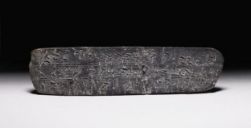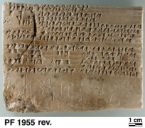Palm leaf-shaped clay tablets
There are two shapes of Linear B clay tablets: rectangular page-shaped clay tablets and palm-leaf shaped tablets which are often smaller. The elongated shape of the latter type of clay tablets is easy to construct by squashing flat a roll of clay. In particular because of the nerve in the middle of these clay tablets, its shape is reminiscent of the shape of palm leaves –although some palmleaf-shaped tablets contain more than one nerve.
Palm leaf tablets often record a single line of information about one person or location along the horizontal axis, whereas some of the bigger page-shaped tablets consist of many lines listing personnel or cattle. The bigger shape and more sophisticated textual organization made this type of page-shaped clay tablets more suitable for greater amounts of data.
The script on this tablet (as on the one above) is called Linear B. Like Cuneiform, one of the earliest writing systems, this old Mycenaean script has survived on clay. At this earliest stage of writing, the invention of new writing systems went hand in hand with a long quest for more writable media than hard stone. In all regions of the world new writing materials were discovered or invented: clay between the fertile rivers of Mesopotamia, papyrus from the papyrus plant across the Nile Delta, bones and silk in China and baked palm leaves in other regions of Southeast Asia. These are just examples of writing materials that have stood the test of time: the permanence of the newly invented writing media was a determining factor for which old writing systems are known to us now.
The Linear B script has been found on clay tablets such as this one during excavations in the Aegean world. In the past 150 years, this old Mycenaean script has been discovered and deciphered. The knowledge we have nowadays about the Mycenaean civilization and their Linear B script is partly due to the material on which this script survived. Without clay, none of these Linear B texts (and many other old writing systems) would have survived. This raises the intriguing but irresolvable question how many Linear B texts have been lost that were not written on clay.


